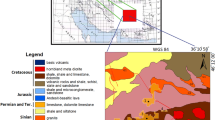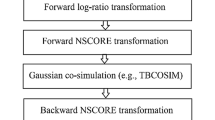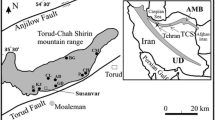Abstract
Separation of geochemical anomalies from the background using various methods for identifying areas of higher mineral potential is a critical first step in Greenfield and Brownfield programs. There are several methods for differentiating anomalous regions from the background. The U-spatial statistics is an effective technique that provides the opportunity of reaching this goal by considering the geochemical sample locations in the separation of geochemical anomalies. In this study, a developed form of the U-spatial statistics method is introduced, which not only considers the existence of anisotropic spatial variations in input data but also reduces the computational (CPU) time. While the previous method is based on the isotropic assumption in the study area and a set of search windows at different times, here, the geochemical anomaly is determined by pasting only one ellipsoid window, effectively combining the flexibility of the U-spatial statistics method with the advantages of geostatistical approaches. This paper compares various approaches (the previous and developed version of the U-spatial statistics method, concentration-area (C–A) fractal model, and probability diagram modeling) for the separation of anomalous areas in the presence of heterogeneous spatial variations. This is done with an application to a Baghqloom porphyry copper deposit located in southeastern Iran. The high potential areas identified via different approaches show an anomalous region in central parts of the Baghqloom area, which partially coincides with an intense potassic alteration area. Compared to other methods, our algorithm separated the high potential areas at a greater spatial resolution.



















Similar content being viewed by others
References
Sinclair AJ (1991) A fundamental approach to threshold estimation in exploration geochemistry: probability plots revisited. J Geochem Explor 41(1-2):1–22
Xie X, Wang X, Zhang Q, Zhou G, Cheng H, Liu D, Cheng Z, Xu S (2008) Multi-scale geochemical mapping in China. Geochem Explor Env A 8(3-4):333–341
Parsa M, Maghsoudi A, Yousefi M (2018) A receiver operating characteristics-based geochemical data fusion technique for targeting undiscovered mineral deposits. Nat Resour Res 27(1):15–28
Stanley CR, Sinclair AJ (1989) Comparison of probability plots and the gap statistic in the selection of thresholds for exploration geochemistry data. J Geochem Explor 32(1-3):355–357
Cheng Q, Agterberg FP, Ballantyne SB (1994) The separation of geochemical anomalies from background by fractal methods. J Geochem Explor 51(2):109–130
Reimann C, Filzmoser P, Garrett RG (2005) Background and threshold: critical comparison of methods of determination. Sci Total Environ 346(1-3):1–16
Zuo R, Cheng Q, Xia Q (2009) Application of fractal models to characterization of vertical distribution of geochemical element concentration. J Geochem Explor 102(1):37–43
Ghavami-Riabi R, Seyedrahimi-Niaraq MM, Khalokakaie R, Hazareh MR (2010) U-spatial statistic data modeled on a probability diagram for investigation of mineralization phases and exploration of shear zone gold deposits. J Geochem Explor 104(1-2):27–33
Carranza EJM (2011) Analysis and mapping of geochemical anomalies using logratio-transformed stream sediment data with censored values. J Geochem Explor 110(2):167–185
Nazarpour A, Omran NR, Paydar GR, Sadeghi B, Matroud F, Nejad AM (2015) Application of classical statistics, logratio transformation and multifractal approaches to delineate geochemical anomalies in the Zarshuran gold district, NW Iran. Chem Erde-Geochem 75(1):117–132
Cheng Q (1999) Spatial and scaling modelling for geochemical anomaly separation. J Geochem Explor 65(3):175–194
Gonçalves MA, Mateus A, Oliveira V (2001) Geochemical anomaly separation by multifractal modelling. J Geochem Explor 72(2):91–114
Li C, Ma T, Shi J (2003) Application of a fractal method relating concentrations and distances for separation of geochemical anomalies from background. J Geochem Explor 77(2-3):167–175
Afzal P, Khakzad A, Moarefvand P, Omran NR, Esfandiari B, Alghalandis YF (2010) Geochemical anomaly separation by multifractal modeling in Kahang (Gor Gor) porphyry system, Central Iran. J Geochem Explor 104(1-2):34–46
Pazand K, Hezarkhani A, Ataei M, Ghanbari Y (2011) Application of multifractal modeling technique in systematic geochemical stream sediment survey to identify copper anomalies: a case study from Ahar, Azarbaijan, Northwest Iran. Chem Erde-Geochem 71(4):397–402
Ghannadpour SS, Hezarkhani A, Eshqi H (2012) Average and variance estimation programming in normal logarithmic distribution. Global J Comput Sci 2(1):1–6
Agterberg FP (2013) Fractals and spatial statistics of point patterns. J Earth Sci 24(1):1–11
Afzal P, Alghalandis YF, Moarefvand P, Omran NR, Haroni HA (2012) Application of power-spectrum–volume fractal method for detecting hypogene, supergene enrichment, leached and barren zones in Kahang Cu porphyry deposit, Central Iran. J Geochem Explor 112:131–138
Afzal P, Harati H, Alghalandis YF, Yasrebi AB (2013) Application of spectrum–area fractal model to identify of geochemical anomalies based on soil data in Kahang porphyry-type Cu deposit, Iran. Chem Erde-Geochem 73(4):533–543
Fereydooni H, Mojeddifar S (2017) A directed matched filtering algorithm (DMF) for discriminating hydrothermal alteration zones using the ASTER remote sensing data. Int J Appl Earth Obs Geoinf 61:1–13
Wang J, Zuo R (2018) Identification of geochemical anomalies through combined sequential Gaussian simulation and grid-based local singularity analysis. Comput Geosci 118:52–64
Ghasemzadeh S, Maghsoudi A, Yousefi M, Mihalasky MJ (2019) Stream sediment geochemical data analysis for district-scale mineral exploration targeting: Measuring the performance of the spatial U-statistic and CA fractal modeling. Ore Geol Rev 113:103–115
Fereydooni H, Moradzadeh A, Pahlavani P, Mojeddifar S (2020) Full unmixing hydrothermal alteration minerals mapping by integration of pattern recognition network and directed matched filtering algorithm. Earth Sci. Inform. 1-15
Talesh Hosseini S, Asghari O, Haroni HA (2020) Multivariate anomaly modeling of primary geochemical halos by U-spatial statistic algorithm development: a case study from the Sari Gunay epithermal gold deposit, Iran. Ore Geol. Rev. 103845.
Shen P, Shen Y, Liu T, Meng L, Dai H, Yang Y (2009) Geochemical signature of porphyries in the Baogutu porphyry copper belt, western Junggar, NW China. Gondwana Res 16(2):227–242
Fu KA (2012) An Application of U-Statistics to Nonparametric Functional Data Analysis. Commun Stat Theor M 41(9):1532–1542
Shen P, Shen Y, Pan H, Li XH, Dong L, Wang J, Zhu H, Dai H, Guan W (2012) Geochronology and isotope geochemistry of the Baogutu porphyry copper deposit in the West Junggar region, Xinjiang. China J Asian Earth Sci 49:99–115
Wendler M (2012) U-processes, U-quantile processes and generalized linear statistics of dependent data. Stoch Process Appl 122(3):787–807
Hassanpour, Afzal P (2013) Application of concentration–number (C–N) multifractal modeling for geochemical anomaly separation in Haftcheshmeh porphyry system. NW Iran Arab J Geosci 6(3):957–970
Soltani F, Afzal P, Asghari O (2014) Delineation of alteration zones based on Sequential Gaussian Simulation and concentration–volume fractal modeling in the hypogene zone of Sungun copper deposit, NW Iran. J Geochem Explor 140:64–76
Tennant CB, White ML (1959) Study of the distribution of some geochemical data. Econ Geol 54(7):1281–1290
Sinclair AJ (1981) The application of probability graphs in mineral exploration. Ass. Geochemist. Explore. 95
Ahmadi R, Fereidooni H (2019) Evaluation of performance of non-linear geostatistical estimation methods to estimate tonnage-grade of the Chah-bashe iron deposit, Yazd province. J of Advanced Appl Geol 9(2):180–194. https://doi.org/10.22055/aag.2019.27793.1908
Lima A, De Vivo B, Cicchella D, Cortini M, Albanese S (2003) Multifractal IDW interpolation and fractal filtering method in environmental studies: an application on regional stream sediments of (Italy), Campania region. Appl Geochem 18:1853–1865
Cheng Q, Agterberg FP, Bonham-Carter GF (1996) A spatial analysis method for geochemical anomaly separation. J Geochem Explor 56(3):183–195
Cheng QM (2007) Mapping singularities with stream sediment geochemical data for prediction of undiscovered mineral deposits in Gejiu, Yunnan Province. China Ore Geol Rev 32:314–324
Zuo R, Xia Q, Zhang D (2013) A comparison study of the C–A and S–A models with singularity analysis to identify geochemical anomalies in covered areas. Appl Geochem 33:165–172
Sinclair AJ (1974) Selection of threshold values in geochemical data using probability graphs. J Geochem Explor 3(2):129–149
Stanley CR, Sinclair AJ (1991) A fundamental approach to threshold estimation in exploration geochemistry, probability plots revisited. J Geochem Explor 41:1–22
Risdianto D, Kusnadi D (2010) April. The Application of a Probability Graph in Geothermal Exploration. In Proc. World Geothermal Congress, 25-29
Gent M, Menendez M, Toraño J, Toraño S (2011) A review of indicator minerals and sample processing methods for geochemical exploration. J Geochem Explor 110(2):47–60
Ghezelbash R, Maghsoudi A (2018) Comparison of U-spatial statistics and C–A fractal models for delineating anomaly patterns of porphyry-type Cu geochemical signatures in the Varzaghan district. NW Iran C R Geosci 350(4):180–191
Cheng Q, Xu Y, Grunsky E (2000) Integrated spatial and spectrum method for geochemical anomaly separation. Nat Resour Res 9(1):43–52
Ghannadpour SS, Hezarkhani A, Farahbakhsh E (2014) Anomaly-background separation and geochemical map generation for Pb and Zn in Parkam district based on U-statistical method, Kerman. Iran Int J Econ Env Geol 4(2):29–36
Ghannadpour SS, Hezarkhani A (2016) Introducing 3D U-statistic method for separating anomaly from background in exploration geochemical data with associated software development. J Earth Syst Sci 125(2):387–401
Mohammadi NM, Hezarkhani A, Saljooghi BS (2016) Separation of a geochemical anomaly from background by fractal and U-statistic methods, a case study: Khooni district, Central Iran. Chem Erde-Geochem 76(4):491–499
Xiao F, Wang K, Hou W, Erten O (2020) Identifying geochemical anomaly through spatially anisotropic singularity mapping: A case study from silver-gold deposit in Pangxidong district, SE China. J Geochem Explor 210:106453
Samal AR, Sengupta RR, Fifarek RH (2011) Modelling spatial anisotropy of gold concentration data using GIS-based interpolated maps and variogram analysis: Implications for structural control of mineralization. J Earth Syst Sci 120(4):583–593
Cao L, Cheng QM (2012) Quantification of anisotropic scale invariance of geochemical anomalies associated with Sn -Cu mineralization in Gejiu, Yunan Province. China J Geochem Explor 122:47–54
Talesh Hosseini S, Asghari O, Ghavami Riabi SR (2018) Spatial modelling of zonality elements based on compositional nature of geochemical data using geostatistical approach: a case study of Baghqloom area, Iran. Journal of Mining and Environment 9(1):153–167
Dimitrakopoulos R, Luo X (2004) Generalized sequential Gaussian simulation on group size ν and screen-effect approximations for large field simulations. Math Geosci 36(5):567–591
Delbari M, Afrasiab P, Loiskandl W (2009) Using sequential Gaussian simulation to assess the field-scale spatial uncertainty of soil water content. Catena. 79(2):163–169
Pawlowsky-Glahn V, Egozcue JJ (2006) Compositional data and their analysis: an introduction. Geol Soc Spec Publ 264(1):1–10
Zuo R, Xia Q, Wang H (2013) Compositional data analysis in the study of integrated geochemical anomalies associated with mineralization. Appl Geochem 28:202–211
Aitchison J (1983) Principal component analysis of compositional data. Biometrika. 70(1):57–65
Egozcue JJ, Pawlowsky-Glahn V, Mateu-Figueras G, Barcelo-Vidal C (2003) Isometric logratio transformations for compositional data analysis. Math Geosci 35(3):279–300
Filzmoser P, Hron K, Reimann C (2009) Univariate statistical analysis of environmental (compositional) data: problems and possibilities. Sci Total Environ 407(23):6100–6108
Aitchison J (1986) The statistical analysis of compositional data. Chapman and Hall, London. Reprinted in 2003 by Blackburn Press, 416 p
Manchuk JG (2008) Guide to geostatistics with compositional data. Guidebook Series, (7)
Talebi H, Mueller U, Tolosana-Delgado R, van den Boogaart KG (2019) Geostatistical Simulation of Geochemical Compositions in the Presence of Multiple Geological Units: Application to Mineral Resource Evaluation. Math Geosci 51(2):129–153
Safikhani M, Asghari O, Emery X (2017) Assessing the accuracy of sequential gaussian simulation through statistical testing. Stoch Env Res Risk A 31(2):523–533
Ghane B, Asghari O (2017) Modeling of mineralization using minimum/maximum autocorrelation factor: case study Sury Gunay gold deposit NW of Iran. Geochem Explor Env A 17(3):186–193
Talesh Hosseini S, Asghari O, Torabi SA, Abedi M (2020) An Optimum Selection of Simulated Geological Models by Multi-Point Geostatistics and Multi-Criteria Decision-Making Approaches; a Case Study in Sungun Porphyry-Cu deposit, Iran. Journal of Mining and Environment 11(2):481–503
Yu Q, Tang W, Kowalski J, Tu XM (2011) Multivariate U-statistics: a tutorial with applications. Wiley Interdiscip. Rev Comput Stat 3(5):457–471
Peck R, Devore JL (2011) Statistics: The exploration & analysis of data. Cengage Learning
Hassanipak AA, Sharafudin M (2011) Exploration Data Analysis. Tehran University Publications, Tehran, Iran, Third edition
Talesh Hosseini S, (2016) Application of U-spatial statistic method, based on the anisotropy modeling, to separate anomaly from background and comparison with probability modeling method from region of Kerman baghqloom. MSc thesis, Shahrood University of Technology-Iran. 159 pp
Talesh Hosseini S, Ghavami-Riabi SR, Asghari O (2016) Determine the anomalous areas using combining the results of geostatistical simulation and probability diagram modeling (case study: Kerman Baghqloom). Sixth Mining Engineering conference of Iran (in Iran)
Ghannadpour SS, Hezarkhani A (2012) Developed software to calculate the additive constant number of average in three-variable normal logarithm. Global J Comput Sci 2(1):1–6
Geology society of Iran, (2003) Geology map (1/5000) of Baghqloom.
Zuo R (2011) Identifying geochemical anomalies associated with Cu and Pb–Zn skarn mineralization using principal component analysis and spectrum–area fractal modeling in the Gangdese Belt, Tibet (China). J Geochem Explor 111(1-2):13–22
Thompson M, Howarth RJ (1976) Duplicate analysis in geochemical practice. Part I Theoretical approach and estimation of analytical reproducibility Analyst 101(1206):690–698
Armstrong M, Dowd PA (2013) Geostatistical Simulations: Proceedings of the Geostatistical Simulation Workshop, Fontainebleau, France, 27–28 May 1993 (Vol. 7). Springer Science & Business Media
Switzer P, Green AA (1984) Min/max autocorrelation factors for multivariate spatial imagery. In: Billard, L. (ed.) Computer Science and Statistics. The Interface, North Holland, Amsterdam 16:13–16
Leuangthong O, Deutsch CV (2003) Stepwise conditional transformation for simulation of multiple variables. Math Geosci 35(2):155–173
Barnett RM, Manchuk JG, Deutsch CV (2014) Projection pursuit multivariate transform. Math Geosci 46(3):337–359
Van den Boogaart KG, Mueller U, Tolosana-Delgado R (2017) An affine equivariant multivariate normal score transform for compositional data. Math Geosci 49(2):231–251
Madani N, Abulkhair S (2020) A hierarchical cosimulation algorithm integrated with an acceptance–rejection method for the geostatistical modeling of variables with inequality constraints. Stoch Env Res Risk A 34(10):1559–1589
Acknowledgments
The authors would like to thank Dr. Mahyar Yousefi for his comments, which helped us improve our paper. We also thank the National Iranian Copper Industries Company for their expert opinions and data preparation.
Author information
Authors and Affiliations
Corresponding author
Ethics declarations
Conflict of Interest
On behalf of all authors, the corresponding author declares no competing interests.
Additional information
Publisher’s Note
Springer Nature remains neutral with regard to jurisdictional claims in published maps and institutional affiliations.
Rights and permissions
About this article
Cite this article
Hosseini, S.T., Asghari, O. & Ghavami-Riabi, S.R. Designing a Geostatistical-Based U-Spatial Statistics Algorithm for the Separation of the Anomaly Area: Application at Baghqloom Porphyry Copper System, Southeastern Iran. Mining, Metallurgy & Exploration 38, 1625–1644 (2021). https://doi.org/10.1007/s42461-021-00425-8
Received:
Accepted:
Published:
Issue Date:
DOI: https://doi.org/10.1007/s42461-021-00425-8




